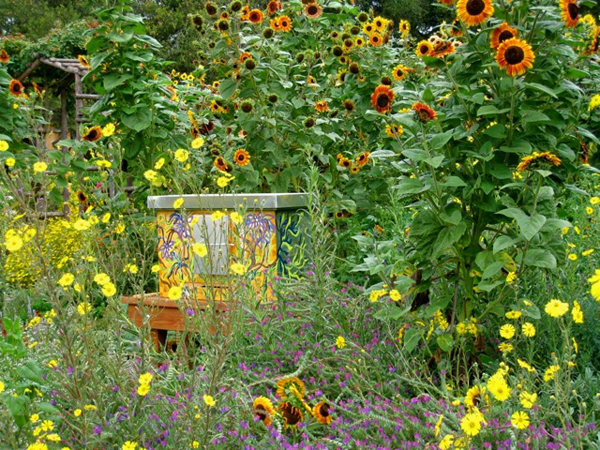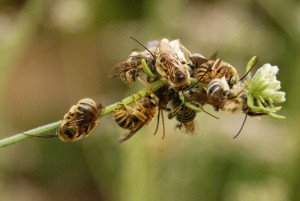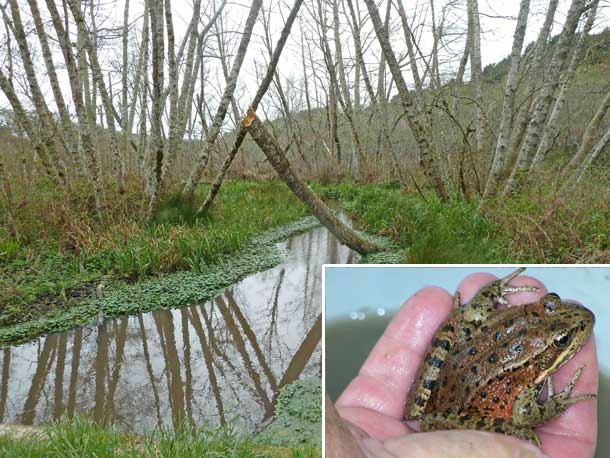Award-winning master gardener Kate Frey believes gardens should be for more than just show. She envisions a world where they’re designed around the needs of living things like bees, birds, and butterflies. A multiple gold medal winner at London’s prestigious Chelsea Garden Show for viticulture and sustainable practices, Frey developed the edible public garden and native landscapes for Fetzer Vineyards in Hopland, and now designs environmentally-oriented gardens and farms in California and abroad.

BN: Are you from the Bay Area?
KF: Yes, I was born in San Francisco, and raised in Berkeley. My father was from Brooklyn and my mother from Minnesota. They met at the University of New Mexico, where they were both in master’s programs. A number of their friends were moving out to San Francisco, and they said that my parents should come along. So they did. My father got a job at UC Berkeley as a librarian and worked there for 35 years.
BN: How did you get involved with gardening?
KF: Growing up I read all kinds of books growing up about nature, animals and travel, and I initially wanted to work outdoors as a naturalist. I especially recall Gerald Durrell’s My Family and Other Animals and Elspeth Huxley’s books about African animals. My mother was not so involved in gardening, but she had a lot of books about the subject. I read a lot of them – that’s all we ever did at home, read. I was captivated by the form and structure Christopher Lloyd, a British writer and gardener, put into his gardens.
After high school, I was lucky to find a job with the State Department of Forestry doing fire prevention. There was a wonderful program at that time providing seasonal employment to people between the ages of 16 and 25. We cut firebreaks with axes and crosscut saws in the Santa Cruz Mountains. Then I got a job with the state parks system in the Gabilan Mountains southeast of San Jose, where I did campground maintenance, trail work, and visitor services. And after that, I worked for the National Forest Service in Idaho, on a timber crew.
Working outside on trails and out in the woods all day, I became interested in everything around me and sought more information. I always had plant I.D. books and tried to learn the names of all the plants in the forest. And I was with other people who had similar interests.
BN: When did you translate these interests into a profession?
KF: I moved to Mendocino in 1983 because I got married and my husband got a job there. There were no opportunities in forestry at that time But my daughters had just been born, so while I was home with them for a couple of years, I focused on learning about gardening through workshops, classes, books, and visiting gardens.
I got my first professional gardening job in 1985, then went on to design and manage the organic public garden at Fetzer vineyards, near Hopland, for 20 years. That garden began with 6 acres, and eventually encompassed 20 acres of irrigated landscape, mostlyedible plants. From the very beginning, we incorporated flowering plants to feed and attract beneficial insects.
I had a lot of interaction with the vineyards, and learned a lot of methods that they used in organic cultivation. One day, I saw this large bespectacled man gesticulating in the garden. He said, “I’m Dr. Frankie from UC Berkeley and this is the best pollinator garden I’ve ever seen.” Dr. Gordon Frankie is the one who really educated me about pollinator gardens.
BN: What is the importance of native plants to pollination?
KF: In terms of bee visits, native plants are favored over exotic plants by four to one. Native bees also visit many exotic plants, but with natives there are more predictable relationships between which bees you see on which flowers. Native bees have co-evolved with native plants, so the bees’ emergence coincides with the flowers emerging.
BN: What are some pollinator-friendly native plants that will thrive in the Bay Area?
KF: Some plants have a wide distribution. The California poppy is an annual native wildflower that’s super easy to grow annual. It reseeds well and bees absolutely love it for pollen and nectar. There are other genera that have a number of different species, each one comfortable in a different ecosystem. If you like the color blue, the Phacelia genus has a whole group of vivid annuals, and a few perennials. Grown world-wide, P tanacetifolia is light blue, and fragrant. P companularia, my personal favorite, is a wonderful deep blue, while P. grandiflora is very similar but a little more showy.

BN: What is your greatest reward from being a master gardener?
KF: I think it’s just being surrounded by gardens that are filled with life. It’s not only gratifying for myself: I feel that I’m able to give to the environment. Instead of being stressed and anxious about human impacts on the environment over the whole world, you can just do a small thing in your own yard and have insects and birds visiting every plant. And I really love to work in public gardens, so the gifts can continue giving. It’s so much fun watching people respond to the gardens, not just to the flowers but to all the life that’s there.
BN: What kinds of challenges do you face in your work?
KF: At the moment, it’s the drought. Also, the fact that people don’t realize how wonderful bee or habitat gardens can be. I just wish everybody would say, yes, I want a habitat garden, but really there are very few such people. I would love it if there were more urban habitat gardens that were more accessible to people, such as our botanical gardens. And I wish that they would emphasize urban horticulture more. There’s a need for urban demonstration gardens.
BN: Can you explain what a habitat garden is?
KF: It’s a garden whose goal is to include plants that support many organisms. These can be edible plants, natives, and non-natives. Every plant I selected for the Fetzer garden had to be low-maintenance, drought-resistant, thrive in inland Mendocino County (which is hot and dry for much of the year, with cold winters), and support insects, butterflies, birds, or beneficial insects. Nearly all plants were selected for beneficial criteria, not just because they had beautiful flowers or form.
BN: What is your favorite outdoor destination in the Bay Area?
KF: The UC Berkeley Botanical Garden in the Berkeley Hills. My parents used to take me there from the time I was an infant. And I’ve always thought it was a magical place, not just a collection of plants from around the world. You could capture a sense of the flavor of those places. Each section of the garden has its own atmosphere and beauty. And it doesn’t matter what season; there’s always something to see. I come down there from Mendocino about once a month.
>> Learn more about Kate and her work at her website, http://freygardens.com
>> Visit Healdsburg’s Melissa Garden





-300x200.jpg)